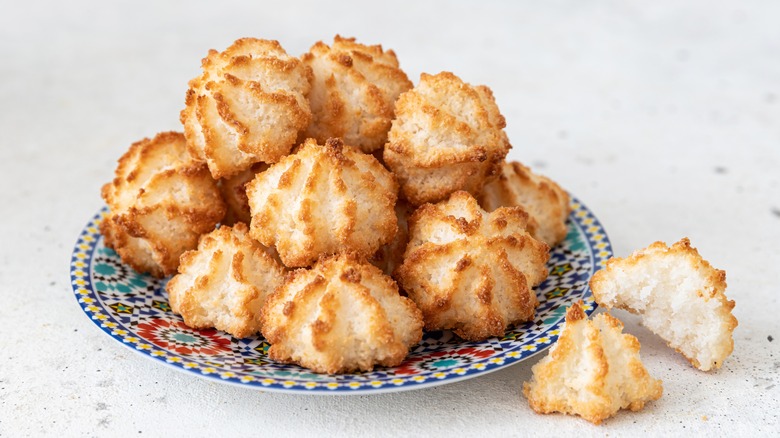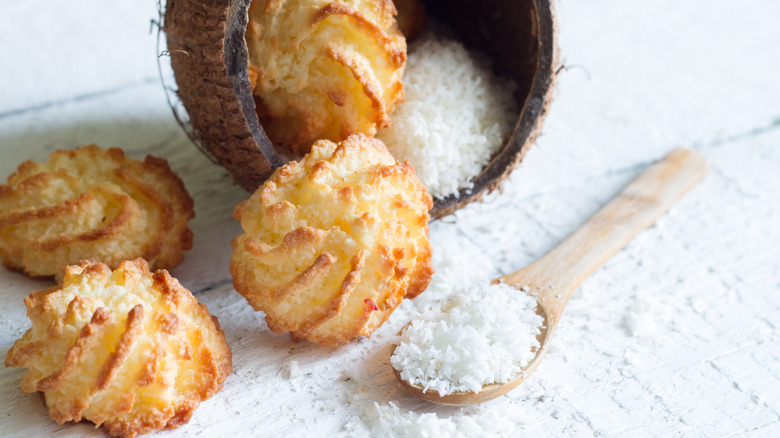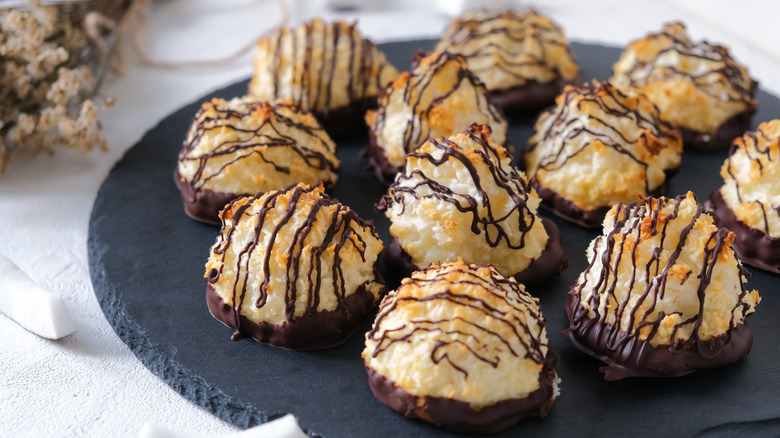Why Macaroons Are A Go-To Passover Dessert
At the Passover Seder, traditional foods are shared and consumed year after year by the Jewish community for their cultural and historical significance to the story of Passover. But no Passover food tradition is more of a nostalgic mystery than the macaroon. As a coconut cookie typically from a tinned can, how did macaroons make their mark with no direct historical connection and cement their place as a must-have Passover dessert?
While the exact origins of the macaroon are murky, we connect the dots somewhere from European monks creating macaroons in monasteries in the eighth century to Eastern European Jews bringing macaroon recipes when immigrating to the United States. Swap out the almonds for shredded coconut, and you have a shelf-stable, sturdy treat that could be easily manufactured, shipped, and sold across the country. Through a combination of marketing efforts by kosher companies, Jewish American families ate up the macaroons and solidified its place as a Passover tradition – sometimes baked fresh, but usually straight from the tin can.
Macaroon ingredients and Kosher dietary restrictions
With ingredients like leavened grains completely banned during Passover, a flourless food is necessary for families to enjoy a dessert during the holiday. Macaroons don't contain any flour; instead, they are made using egg whites and include plenty of sugar. Nowadays, traditional almond macaroons are still made and sold along with other flavors, but macaroons mainly took off once almonds were swapped out for an unexpected tropical ingredient: coconut.
After the ingenious thinking of a Philadelphia flour miller in the late 1800s, shredded coconuts became the key ingredient for making macaroons. Not only was the fresh, tropical flavor intriguing and delicious, but it even helped keep the macaroons fresh for longer. But since coconut was so new and a bit exotic, it was initially considered a delicacy reserved only for the upper class and elite. Gradually, kosher companies like Manischewitz capitalized on this opportunity and began selling certified kosher tinned macaroons, making them more widely available to American Jews nationwide.
The macaroon boom and a lasting tradition
Just as the sales of many processed foods exploded in the 1950s, so did the sales of pre-made, processed macaroons. Shredded coconut became very hard to come by during World War II. But post-war, coconut became readily available again, making way for a macaroon boom. By continuing to market the macaroons during the holiday season, these companies helped create a connection in the minds of Jewish Americans: When you shop for Passover Seder dinner, you've got to buy a can of macaroons. There is no need to make them at home.
Nowadays, some Jewish Americans choose to restore old macaroon recipes by baking homemade coconut macaroons from scratch or creating new varieties of macaroons. But the tinned macaroons from Manischewitz or Streit's still live on. Although the beloved macaroon doesn't have a direct connection to the story of the Jewish people's flight from Egypt, the macaroon's spirit and the spirit of Passover and the Jewish community go hand in hand: A spirit of resilience, innovation, and building traditions.


